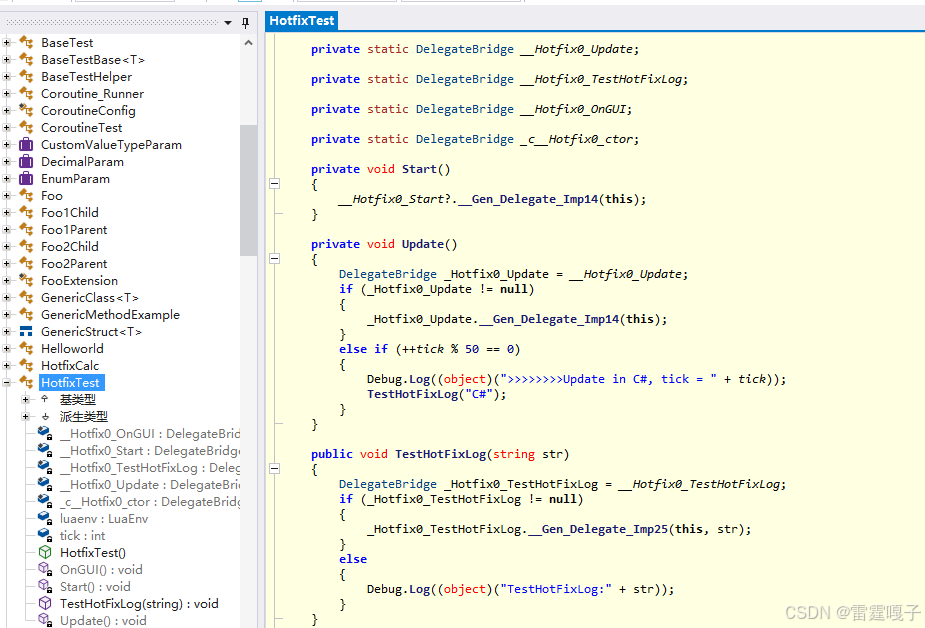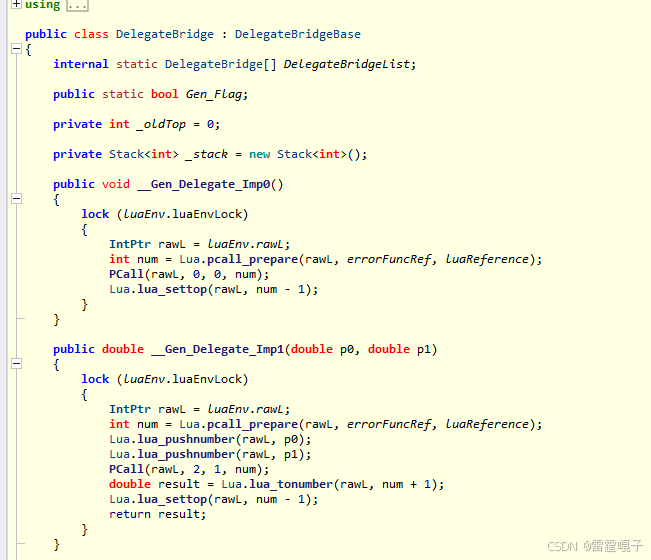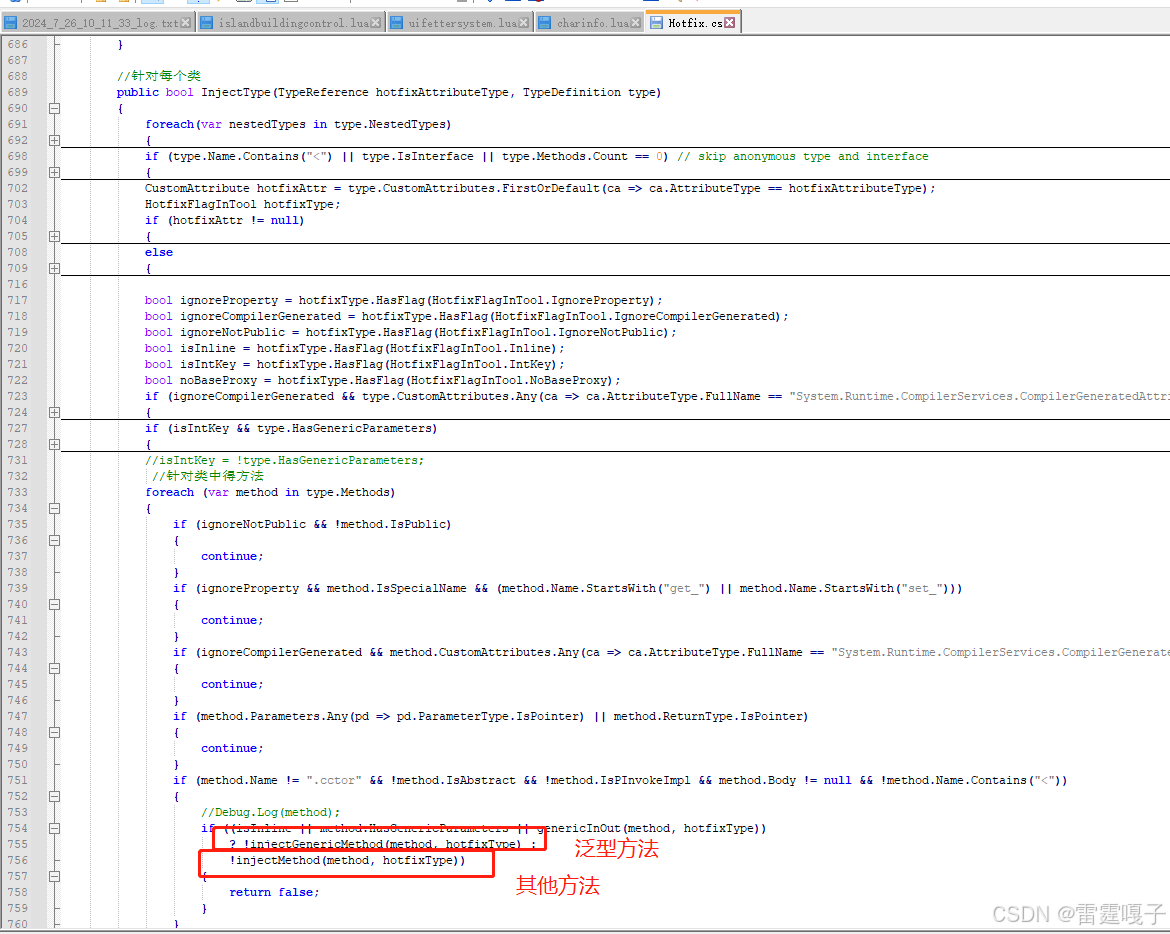前面已经介绍了Xlua的通信原理,这篇主要记录Xlua如何做到Hotfix的。
我们项目就用到Xlua的Hotfix特性,周更用Lua去修改代码。版本内用C#开发。这点我觉得是Xlua比toLua强大的重要特性之一。
如何使用Hotfix本篇不介绍了,看Xlua教程懂得都懂,着重于原理部分。
一、如何进行Hotfix
先上测试代码:
void Update() { if (++tick % 50 == 0) { Debug.Log(">>>>>>>>Update in C#, tick = " + tick); TestHotFixLog("C#"); } } public void TestHotFixLog(string str) { Debug.Log("TestHotFixLog:" + str); } void OnGUI() { if (GUI.Button(new Rect(10, 10, 300, 80), "Hotfix")) { luaenv.DoString(@" xlua.hotfix(CS.XLuaTest.HotfixTest, 'Update', function(self) self.tick = self.tick + 1 if (self.tick % 50) == 0 then print('<<<<<<<<Update in lua, tick = ' .. self.tick) self:TestHotFixLog('lua') end end) "); } }使用反编译编译Library\ScriptAssemblies\Assembly-CSharp.dll。可以看到这段

可以清晰的看到,反编译后是生成了一些委托,如果委托函数有值就不走原函数。
看看DelegateBridge 的结构:

对应上面的Update的这个函数,又看到了熟悉的压栈操作,通过这样的方式可实现热修

C#端的基础原理搞清后。看看xlua.hotfix都干了什么事。
xlua.hotfix = function(cs, field, func) if func == nil then func = false end local tbl = (type(field) == 'table') and field or {[field] = func} for k, v in pairs(tbl) do local cflag = '' if k == '.ctor' then cflag = '_c' k = 'ctor' end local f = type(v) == 'function' and v or nil xlua.access(cs, cflag .. '__Hotfix0_'..k, f) -- at least one pcall(function() for i = 1, 99 do xlua.access(cs, cflag .. '__Hotfix'..i..'_'..k, f) end end) end xlua.private_accessible(cs) endcs对应改的C#类,跟上面的反编译脚本一致。
field一个字符串
func方法。
可以看到他这里拼接了字符串,然后去向C#的委托去传递这个方法。
xlua.access(cs, cflag .. '__Hotfix0_'..k, f) -- at least one 这里对应上述修改的__Hotfix0_Update
后面1-99 是修改了重载函数,造成了一定的性能损失。
PS:我们项目不允许C#代码使用同名重载函数,会出现很多意外的问题,可能就跟这里有关
再刨个根吧,看看xlua.access的实现:
[MonoPInvokeCallback(typeof(LuaCSFunction))] public static int XLuaAccess(RealStatePtr L) { try { ObjectTranslator translator = ObjectTranslatorPool.Instance.Find(L); Type type = getType(L, translator, 1); object obj = null; if (type == null && LuaAPI.lua_type(L, 1) == LuaTypes.LUA_TUSERDATA) { obj = translator.SafeGetCSObj(L, 1); if (obj == null) { return LuaAPI.luaL_error(L, "xlua.access, #1 parameter must a type/c# object/string"); } type = obj.GetType(); } if (type == null) { return LuaAPI.luaL_error(L, "xlua.access, can not find c# type"); } string fieldName = LuaAPI.lua_tostring(L, 2); BindingFlags bindingFlags = BindingFlags.Public | BindingFlags.NonPublic | BindingFlags.Instance | BindingFlags.Static; if (LuaAPI.lua_gettop(L) > 2) // set { var field = type.GetField(fieldName, bindingFlags); if (field != null) { field.SetValue(obj, translator.GetObject(L, 3, field.FieldType)); return 0; } var prop = type.GetProperty(fieldName, bindingFlags); if (prop != null) { prop.SetValue(obj, translator.GetObject(L, 3, prop.PropertyType), null); return 0; } } else { var field = type.GetField(fieldName, bindingFlags); if (field != null) { translator.PushAny(L, field.GetValue(obj)); return 1; } var prop = type.GetProperty(fieldName, bindingFlags); if (prop != null) { translator.PushAny(L, prop.GetValue(obj, null)); return 1; } } return LuaAPI.luaL_error(L, "xlua.access, no field " + fieldName); } catch (Exception e) { return LuaAPI.luaL_error(L, "c# exception in xlua.access: " + e); } }这里是使用了type获取元数据进行调用。
至此,xlua的hotfix原理已经清晰了。
util.hotfix就是先执行一遍lua的函数体,然后再执行一遍hotfix。所以可以执行原函数
--和xlua.hotfix的区别是:这个可以调用原来的函数 local function hotfix_ex(cs, field, func) assert(type(field) == 'string' and type(func) == 'function', 'invalid argument: #2 string needed, #3 function needed!') local function func_after(...) xlua.hotfix(cs, field, nil) local ret = {func(...)} xlua.hotfix(cs, field, func_after) return unpack(ret) end xlua.hotfix(cs, field, func_after) end二、如何生成程序集
- Generate Code
这一步主要根据是根据C#类中需要支持热更的方法生成其对应的委托方法,但是并不是每个方法对应一个委托,而是根据调用参数和返回参数公用委托。这块之前有详细介绍代码,就不复述了。 - Hotfix Inject
这一步主要是对Unity编译出的Dll中的C#类添加判断条件,以此来选择调用Lua中的修复方法还是直接执行C#代码
这一步是在Unity为C#代码生成完对应dll之后,由XLua再来对dll注入一些判断条件式来完成是否进行Lua调用的行为。
判断方法很简单,检查对应类静态字段是否有DelegateBridge对象。
实现如下:

bool injectMethod(MethodDefinition method, HotfixFlagInTool hotfixType) { var type = method.DeclaringType; bool isFinalize = (method.Name == "Finalize" && method.IsSpecialName); //__Gen_Delegate_Imp 方法引用 MethodReference invoke = null; int param_count = method.Parameters.Count + (method.IsStatic ? 0 : 1); //根据返回值和参数个数类型和方法全名找对应的C#方法 if (!findHotfixDelegate(method, out invoke, hotfixType)) { Error("can not find delegate for " + method.DeclaringType + "." + method.Name + "! try re-genertate code."); return false; } if (invoke == null) { throw new Exception("unknow exception!"); } #if XLUA_GENERAL invoke = injectAssembly.MainModule.ImportReference(invoke); #else invoke = injectAssembly.MainModule.Import(invoke); #endif //插入的类静态字段,用来标记对应的方法是否有对应的Lua注入 FieldReference fieldReference = null; //方法中的变量定义 VariableDefinition injection = null; //IntKey前面InjectType设置过,没有泛型参数并且是同一个程序集 bool isIntKey = hotfixType.HasFlag(HotfixFlagInTool.IntKey) && !type.HasGenericParameters && isTheSameAssembly; //isIntKey = !type.HasGenericParameters; if (!isIntKey) { //新建变量,看起来跟重载函数有关系 injection = new VariableDefinition(invoke.DeclaringType); method.Body.Variables.Add(injection); //luaDelegateName 是个string方法名称 //获取这个方法对应的委托名,因为有重载方法存在,所以之前已经注入的过的方法会在这边获取时候计数加1, //比如第一个重载获取的是__Hotfix0,那么下一个重载会是__Hotfix1,判断是否注入就是是否设置对应FieldReference。 var luaDelegateName = getDelegateName(method); //一般不error,除非超过 MAX_OVERLOAD 100个。 if (luaDelegateName == null) { Error("too many overload!"); return false; } //创建对应的静态Field名字就是上面取到的luaDelegateName FieldDefinition fieldDefinition = new FieldDefinition(luaDelegateName, Mono.Cecil.FieldAttributes.Static | Mono.Cecil.FieldAttributes.Private, invoke.DeclaringType); type.Fields.Add(fieldDefinition); fieldReference = fieldDefinition.GetGeneric(); } bool ignoreValueType = hotfixType.HasFlag(HotfixFlagInTool.ValueTypeBoxing); //IL插入位置,现在定位的是方法体的第一行 var insertPoint = method.Body.Instructions[0]; //获取IL处理器 var processor = method.Body.GetILProcessor(); //构造函数换个位置插。先不管了 if (method.IsConstructor) { insertPoint = findNextRet(method.Body.Instructions, insertPoint); } Dictionary<Instruction, Instruction> originToNewTarget = new Dictionary<Instruction, Instruction>(); HashSet<Instruction> noCheck = new HashSet<Instruction>(); while (insertPoint != null) { Instruction firstInstruction; //isIntKey这边用到的是Xlua中的AutoIdMap,这边只对最基础的功能做分析,这边就分析基础的注入了。 if (isIntKey) { firstInstruction = processor.Create(OpCodes.Ldc_I4, bridgeIndexByKey.Count); processor.InsertBefore(insertPoint, firstInstruction); //调用方法 processor.InsertBefore(insertPoint, processor.Create(OpCodes.Call, hotfixFlagGetter)); } else { //创建第一条IL语句,获取类的静态Field压入方法栈中,其实就是之前luaDelegateName获取的字段(换句话说这里就是创建诸如 __Hotfix0_Start;) firstInstruction = processor.Create(OpCodes.Ldsfld, fieldReference); //插入insertPoint之前 processor.InsertBefore(insertPoint, firstInstruction); //创建并插入IL,获取栈顶的值并压入到对应的变量中,injection就是我们之前创建的新建变量 processor.InsertBefore(insertPoint, processor.Create(OpCodes.Stloc, injection)); //创建并插入IL,压入变量体中的值到栈 processor.InsertBefore(insertPoint, processor.Create(OpCodes.Ldloc, injection)); } //创建跳转语句,为false时候直接跳转insertPoint, //这边OpCodes.Brfalse看起来是布尔值判断,其实也会判断是否为null var jmpInstruction = processor.Create(OpCodes.Brfalse, insertPoint); processor.InsertBefore(insertPoint, jmpInstruction); if (isIntKey) { //创建当前指令参数数据源并后续调用 processor.InsertBefore(insertPoint, processor.Create(OpCodes.Ldc_I4, bridgeIndexByKey.Count)); //创建委托函数对象 processor.InsertBefore(insertPoint, processor.Create(OpCodes.Call, delegateBridgeGetter)); } else { //创建并插入IL,再次压入变量的值,因为上面做完判断后,栈顶的值就会被弹出,所以这边要再次压入 processor.InsertBefore(insertPoint, processor.Create(OpCodes.Ldloc, injection)); } //成员函数比静态函数多了个参数,即自身,这步是压栈参数个数 for (int i = 0; i < param_count; i++) { if (i < ldargs.Length) { processor.InsertBefore(insertPoint, processor.Create(ldargs[i])); } else if (i < 256) { processor.InsertBefore(insertPoint, processor.Create(OpCodes.Ldarg_S, (byte)i)); } else { processor.InsertBefore(insertPoint, processor.Create(OpCodes.Ldarg, (short)i)); } if (i == 0 && !method.IsStatic && type.IsValueType) { processor.InsertBefore(insertPoint, processor.Create(OpCodes.Ldobj, type)); } //对值类型进行Box if (ignoreValueType) { TypeReference paramType; if (method.IsStatic) { paramType = method.Parameters[i].ParameterType; } else { paramType = (i == 0) ? type : method.Parameters[i - 1].ParameterType; } if (paramType.IsValueType) { processor.InsertBefore(insertPoint, processor.Create(OpCodes.Box, paramType)); } } } //创建并插入IL,调用invoke方法,因为之前已经压入injection的值,DelegateBridge的对象 processor.InsertBefore(insertPoint, processor.Create(OpCodes.Call, invoke)); //如果不是结构体,或者isFinalize,从当前方法返回,并将返回值(如果存在)从调用方的计算堆栈推送到被调用方的计算堆栈上。 if (!method.IsConstructor && !isFinalize) { processor.InsertBefore(insertPoint, processor.Create(OpCodes.Ret)); } if (!method.IsConstructor) { break; } else { //普通方法,加入返回操作 originToNewTarget[insertPoint] = firstInstruction; noCheck.Add(jmpInstruction); } //寻找下一个插入位置 insertPoint = findNextRet(method.Body.Instructions, insertPoint); } //结构体的处理 if (method.IsConstructor) { fixBranch(processor, method.Body.Instructions, originToNewTarget, noCheck); } //isFinalize的处理 if (isFinalize) { if (method.Body.ExceptionHandlers.Count == 0) { throw new InvalidProgramException("Finalize has not try-catch? Type :" + method.DeclaringType); } method.Body.ExceptionHandlers[0].TryStart = method.Body.Instructions[0]; } if (isIntKey) { bridgeIndexByKey.Add(method); } return true; }
参考:
xlua hotfix分析
https://zhuanlan.zhihu.com/p/68907610/
OpCodes指令
https://www.cnblogs.com/chenxiaoran/archive/2012/11/19/2776807.html
